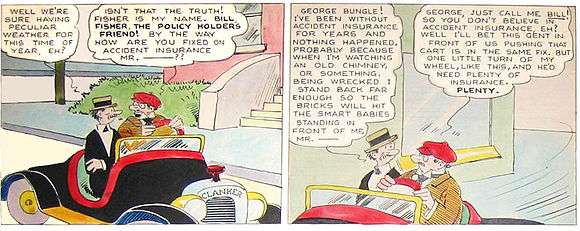The Bungle Family

The Bungle Family was an American gag-a-day comic strip, created by Harry J. Tuthill, that first appeared in 1918. Originally titled Home, Sweet Home, it first appeared as part of a series of rotating strips in the New York Evening Mail.
Characters and story

Called "the finest, most inventive and socially critical of the family strips" by comics historian Bill Blackbeard, The Bungle Family was a popular domestic comedy that emphasized dialogue and realistic situations. The titular patriarch of the strip, long-suffering, cantankerous George Bungle, voiced the petty frustrations and joys of the common man during the Jazz Age and through the Depression.[1]
Seen only sporadically in 1918, the strip was published daily and was nationally syndicated by the end of 1919. Home, Sweet Home followed the adventures of Mabel (later Josephine) and George, a young couple beset on all sides by in-laws, neighbors and businessmen.
Tuthill took the strip to the McNaught Syndicate when the Evening Mail was sold in 1924, changing the name to The Bungle Family and adding daughter Peggy Bungle to the cast. A Sunday page was in existence by September 9, 1923. Comics historian Don Markstein described life among the Bungles:
George was skinny, middle-aged, cucumber-nosed and mustachioed, sort of like A. Mutt, Andy Gump or the self-caricatures of R. Crumb. Josie was his equivalent, not a dowdy old frump, but about as comfortably domestic looking as Mutt's or Andy's wife, or to cite a more recent example, Mrs. Ferd'nand. They were typical lower middle class city people of the time, living in a walk-up apartment and having frequent run-ins with the landlord, bill collectors, neighbors and most of all, each other. George and Jo would fight over practically anything. Their disputes frequently went on for hours, provoked noise complaints to the police, dragged the neighbors in, or all three. They were not very likable, and certainly not high-minded. But they were funny. Through them, Tuthill displayed a sort of amused contempt for the more petty concerns of ordinary urban life. The Bungles weren't the sort of folks most people would want to live downstairs from, but they were very much capable of providing entertainment for those who didn't have to put up with them in person.[2]
In the mid-1930s, Tuthill serialized exotic adventures and introduced a large supporting cast over the next several years—moves that were accompanied by a huge surge of public interest in the strip. Around this time, Tuthill began incorporating fantasy and time travel into the strip.[3]

Reprints
Reprints of the strip were first featured in the comic book Famous Funnies beginning with its first issue in 1934. Despite its fame, the strip was brought to a conclusion by its creator on August 1, 1942. Revived on May 17, 1943, it ended permanently June 2, 1945.[2]

In 1999, The Bungle Family was voted one of the Top 100 English language comics of the 20th Century by The Comics Journal. In 2006, it was announced that Spec Publications, a Colorado-based publisher of classic comics, planned to reprint The Bungle Family in collected editions.
Books
- Home, Sweet Home. New York: M.S. Company, 1925.
- Waugh, Coulton, The Comics, MacMillan, 1947, 1991, p. 110-111.
- The Bungle Family: A Complete Compilation, 1928 / Harry J. Tuthill; introduction by Bill Blackbeard, The Hyperion library of classic American comic strips, Westport, Connecticut: Hyperion Press, 1977. LCCN 76053057 ISBN 0-88355-669-3
- Hunter, Julius K., Westmoreland and Portland places: the history and architecture of America's Premier Private Streets, 1888-1988 (St. Louis, Missouri), University of Missouri Press, Columbia, Missouri, 1988, p. 84.
- The Bungle Family 1930: LOAC Essentials Volume 5: Library of American Comics Essentials, Hardcover – July 15, 2014 / Harry J. Tuthill; IDW Publishing, 2014. ISBN 1613779585 ISBN 978-1613779583
References
- ↑ Blackbeard, Bill (1976). "The Bungle Family". The World Encyclopedia of Comics (ed. Maurice Horn). New York: Chelsea House. ISBN 0-87754-030-6
- 1 2 The Bungle Family at Don Markstein's Toonopedia. Archived from the original on March 6, 2015.
- ↑ The Bungle Family, Hogan's Alley #13
External links
- Flickr
- Lambiek: The Bungle Family
- "The Press: Bungle". Time, August 18, 1930)
- Modern Mechanix, October 1936